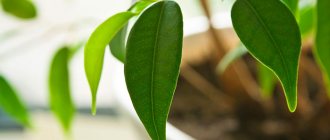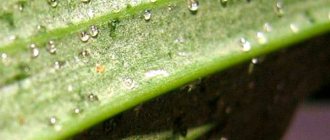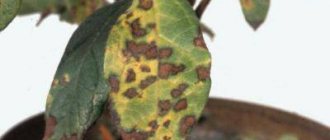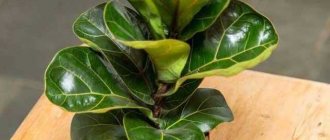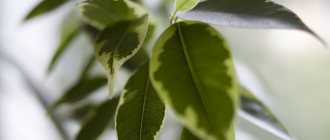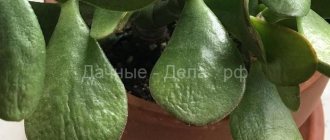Features of growing ficus
When growing ficus, you need to become familiar with the needs of the plant. The optimal room temperature is determined depending on the type. Usually it should be within +18...+20°C, however, there are varieties for which +10°C is optimal. Comfortable air humidity is 50–70%.
Lighting should be bright and diffused. The ficus tree does not like either direct light or darkness, but is shade-tolerant. Moderate watering is preferable; both the soil should not dry out or be excessively waterlogged. Young specimens are transplanted once a year. Plants older than 4 years are replanted less frequently - once every 2-3 years.
Also, we must not forget about fertilizers. The exact frequency of fertilizing depends on the variety, but most often it is necessary to fertilize in the spring-summer period every 1–1.5 weeks with preparations for ornamental foliage plants, for example, with “Rainbow” or “Ideal” products.
Reason #2. Heat and dryness
This is perhaps the most obvious reason why ficus leaves can dry out.
Most representatives of this genus require a fairly cool ambient temperature (especially in winter, and usually not higher than 20-25°C in summer), constantly moderately moist soil, and mandatory regular spraying of the crown or wiping the leaves with a soft damp cloth.
Ficus small-fruited, ficus lyre-shaped, rubber-bearing ficus, ficus natalis, ficus sagitta, ficus microcarpa, ficus dwarf are in great need of humidity “from above and below”, as well as in the absence of dry heat.
Direct sunlight, dry air and soil, underwatering, placement near heating sources in winter - all this is almost guaranteed to lead to withering and drying out of the leaves and young shoots of such plants. In this case, leaf blades often begin to dry from the edges or tips.
Why ficus leaves fall: reasons and what to do
Ficus sheds its leaves for two reasons. This can be either a natural process or a consequence of improper plant maintenance. That is why, before deciding how to save a ficus, you need to determine the exact cause of its condition.
Did you know? The largest ficus banyan tree grows in India. Its age is more than 200 years, the diameter of the main trunk is 12 m. The crown of this tree has grown to 12,000 m² and is supported by collateral and aerial roots that have grown to the size of individual trunks.
Natural process
The normal life rhythm of a ficus includes the stage of shedding its leaves. This is a natural process that occurs in autumn or early winter. Thanks to the loss of leaves, the plant successfully enters a dormant state.
In the future, the leaf plates must grow again. Most often, the ficus first loses the lower parts of the crown. At first they acquire a yellowish color, then they begin to dry out and fall off.
Improper care
Very often, the reason for the loss of foliage by a ficus is the wrong approach to its maintenance. Microclimate disturbances, improper watering and replanting negatively affect the condition of the plant, which is why the leaves begin to fall.
Violation of containment conditions
The microclimate plays a very important role when growing ficus. Cold and drafts are extremely harmful to the plant. For most species, if the temperature drops below +16°C, the foliage is highly likely to fall.
Important! It is highly advisable to avoid sudden changes in temperature, humidity or light levels. The plant does not like change, including a change of location.
You should also avoid exposure to high temperatures. Although ficus is classified as a heat-loving species, at temperatures above +30°C the plant withers, the leaf blades change color to yellowish and have difficulty remaining on the stem. However, it is necessary to pay attention to the specific species being grown and the optimal indicators for it.
An important factor is the level of moisture in the air. Leaves often fall off due to excessive dryness. This often happens in the summer, when it is quite hot outside and the air in the room also warms up above normal.
However, even in winter there is a risk of increased air dryness due to the operation of radiators or heaters. The owner needs to monitor the humidity and, if necessary, adjust its levels using special air humidifiers.
We must not forget about lighting. Species characterized by a variegated pattern on the leaf blades do not tolerate light shading. Varieties with green leaves can grow in partial shade.
Also find out what to do if ficus benjamina loses its leaves.
However, too strong a shadow has a detrimental effect on the condition of any ficus. As a result of being placed in a dark space, symptoms may occur in the form of weakening of the crown, lethargy, withered foliage and, as a result, its falling.
Improper watering
Watering the ficus should be moderate. The soil should not be allowed to dry out too much. A similar situation can happen due to poor or infrequent soil moisture. As a result, the crown dries out, turns yellow and does not stay on the trunk for a long time.
A similar effect occurs if watering, on the contrary, is too abundant. You should not allow water to stagnate in the soil, as the process of root rot begins. It can be identified by its unpleasant putrid odor. If the situation is not corrected in time by adjusting the watering, gradual damage to the trunk begins. The leaves acquire a dark color and fall off the stem.
Read more about the features of watering ficus at home.
Incorrect transplant
Since ficus trees do not tolerate any changes well, a reaction in the form of dropping leaves may occur during transplantation. It is for this reason that the plant cannot be replanted often.
The maximum frequency of changing the pot and soil is 2 times a year. Often gardeners, knowing about the possible reaction of the plant, resort to only a superficial change of soil instead of a full transplant.
Pesticides
When dealing with pests, pesticides become the first resort for many home plant owners. Chemical-based substances are also used to prevent the development of various diseases.
The effect of intensive treatment of ficus with such drugs is often negative. Pesticides are dangerous because they create a strong load on the plant, as a result of which the leaves do not stay on the trunk, weaken and fly off.
Important! When treating with pesticides and other drugs, safety rules should be followed. It is advisable to use rubber gloves and eye protection in the form of glasses.
Pests and diseases
A common cause of leaf falling is the development of various diseases. Fungal infections are dangerous for ficus. They appear most often due to excessive moisture in the substrate.
In addition to crown shedding, the fungus causes discoloration and spotting on different parts of the plant. As a therapeutic measure, you need to get rid of the affected areas and treat with a fungicide, for example, the drug "Carbendazim".
No less dangerous are pests, among which you can most often find:
- aphids;
- spider mite;
- scale insect.
Insects suck the juices from the leaf blades, as a result of which they weaken and do not adhere to the trunk.
The first aid in this case will be manual collection and destruction of pests using a soap solution. Next, the plant should be treated with a systemic insecticide, for example, Actellik or Inta-vir. We also recommend that you find out what to do if your ficus leaves turn yellow and curl.
Diseases and pests
Also check out these articles
- How to get rid of ants
- Transplanting raspberries in autumn
- How to plant and care for dill
- Zucchini lecho
Why do ficus leaves turn yellow and fall off? The presence of diseases and dangerous insects on the plant is a common cause of such symptoms. Both diseases and insects can be destructive for the plant because they deplete the crop. But, fortunately, they can be recognized in time and countermeasures taken.
Photo of ficus root rot
The first step is to inspect the plant for the presence of pests. Usually the lower leaves show signs of insects, if any live on the plant at all. The ficus is examined from all sides, including the lower part of the plate, as well as the upper layer of the earth. Most often, ficus trees are threatened by spider mites (you can see them on the web) and scale insects (attached to the branches and look like rounded growths). Also, aphids are not indifferent to the culture - they live on the underside of the leaf, thin branches, from where it is easiest to suck out the juice.
To rid the ficus of pests, the branches and leaves are washed with soapy water, then washed with clean water and sprayed with special insecticides (Aktara, Fitoverm, Vermitek, Aktellik). In case of scale insect damage, the pests are collected manually before these procedures.
If the crop is affected by a disease, the leaves will not only fall off, but also change color and become covered with spots and stripes. Ficus trees are susceptible to diseases such as powdery mildew, rust, cercospora blight, gray rot, root rot, and sooty fungus. Typically, the disease appears if the tree is watered abundantly or if contaminated soil is used for planting (transplanting). At the first signs of illness, the ficus is immediately treated with fungicides (Alirin, Oksikhom, Agat, Albit) and the humidity and watering rates are adjusted.
Photo of scale insects on ficus leaves
Why does ficus shed leaves in winter?
Shedding leaves at the beginning of winter can be caused by various reasons.
The main ones are:
- natural transition to a state of dormancy, provided that the crown has fallen at the beginning of the season;
- reduced daylight hours and poor lighting;
- changes in humidity and temperature due to the operation of heating devices in the room.
It is also necessary to remember about other reasons such as diseases, pests or improper care.
Proper care is important for plant health
Ficus Benjamina is native to the tropics. Therefore, you need to provide him with sufficient humidity; he is used to 70–75%. In winter, when the heating is on, it is better to use a humidifier. Or spray regularly with water from a spray bottle.
If the tips of the leaves dry out, it means the air in the room is too dry.
The most difficult thing in caring for a ficus is to ensure proper watering. If there is not enough water, it will shed its leaves. This triggers a protective mechanism that reduces water consumption during periods of drought. Overwatering is even more dangerous. It leads to rotting of the roots, and this process is irreversible. It will be almost impossible to save the flower.
To avoid mistakes in watering, it is recommended to check the soil by hand. You need to let it dry 1.5–2 centimeters deep between waterings, and if the plant is large, then 3–4 centimeters. In winter, it is worth completely reducing watering, doing it once every 10 days.
It is also worth monitoring the fertility of the soil. A young ficus needs a transplant every year; it tolerates it best in the spring. Replanting must be done extremely carefully; the root system of the ficus is very fragile and can be easily damaged. An adult plant can be replanted every three years. In this way, the soil is renewed and the root system receives more space and oxygen for growth. Loose, slightly acidic or neutral soil is suitable for the flower. The bottom of the pot should be well drained.
Treatment with Epin or Zircon helps the ficus recover and accelerates the appearance of new leaves.
Leaves may fall off due to a lack of nutrients if the plant has not been replanted for a long time, changing the soil, and has not been fed. In this case, it is worth introducing fertilizer diluted with water for decorative foliage. Remember that fertilizer should be added to moist soil, otherwise there is a risk of burning the roots. Also, in order to prevent depletion, you can change the top layer of soil every few months.
The plant does not grow in winter, so there is no need to feed it. Additives to the soil may be required only if the leaves of the ficus have become very yellow. This means he lacks iron. Feed it with ferrovite or iron chelate according to the instructions.
How to prevent leaves from falling
To prevent the ficus from shedding its crown, you need to take the following preventive measures:
- maintaining the correct microclimate (temperature, humidity and lighting);
- ensuring a stable location and conditions;
- moderate treatment with chemicals;
- replanting no more than once a year for young (up to 4 years) and once every 2–3 years for older ficuses;
- water the soil in moderation, avoiding waterlogging or drying out of the substrate;
- timely treatment of diseases and pests.
Did you know? The fig tree from which the figs are harvested is a type of ficus.
Reason #3. Overflow
You may be surprised, but for ficus plants with thin leaf blades, overwatering can be just as unpleasant as underwatering!
The same ficus Benjamin, equal-leaved, sacred, dwarf and even rubber-bearing ones will persistently “demand” stable humidity from the owner. Do you transfuse regularly? Got dampness in the pot? Did you pour water at the wrong temperature? Receive yellowing, darkening and leaf drop.
Regular overwatering can even lead to rotting of the roots - you understand, the above-ground part of the plant after this is unlikely to be healthy and decorative, the leaves will begin to wither and fall off.
But, for example, the wall ficus is not so capricious - at least it will tolerate a single severe drought or waterlogging without much damage to itself.
There are also ficuses that require completely different conditions at different times of the year. So, figs (yes, this is also a ficus, though it is deciduous!) in the summer during the growing season will require abundant watering from you, but in the winter during the dormant period it will require very, very moderate watering, as long as the soil does not turn into stone or dry dust.
Useful care tips
In order for the ficus to please its owners for a long time, you should not only adhere to the basic rules, but also learn the intricacies of caring for it:
- The ficus tree is quite undemanding. The main thing is to disturb it as little as possible and maintain stable conditions. In summer, however, it can be taken out onto the terrace or balcony.
- If there are problems with lighting , special lamps can be purchased in flower grower stores.
- In addition to the frequency of watering, water characteristics are important for ficus. It must be soft and no colder than room temperature. Also, the plant is sprayed with warm water when it is extremely dry and the leaves are washed to remove dust and dirt.
The fall of the crown of a ficus is a very annoying problem. However, it can be avoided by adhering to the basic rules of plant care and promptly resorting to treatment of diseases and adjusting the approach to cultivation.
How to save ficus
How to revive a ficus that has begun to rapidly lose leaves? This process begins due to many reasons: a sudden change of location, draft, cold and errors in care, or even lack of care. With a regular lack of lighting, too dry air or waterlogging, “leaf fall” and rapid death of the plant will not take long, so measures should be taken immediately.
If the leaf falls off in large quantities, the first step is to spray the Benjamin ficus with the maintenance drug Epin. Restoring the viability of a plant directly depends on the reasons that caused its disease. Sometimes it is possible to restore the beauty and healthy appearance of a rubber plant with the help of basic measures, without even resorting to scrupulous replanting and lengthy processing.
The main conditions for the normal life of a tree are diffused light, moderate and timely watering, air humidity from 50 to 70 percent and spraying. The soil should dry out a little between water procedures, and the need for watering can be easily determined by checking the condition of the soil in the pot. If its top layer has dried out a little (by two to three centimeters), it’s time to water the ficus. You cannot frequently move the pot from place to place, as this will cause leaf fall to become regular, and it may happen that the plant completely loses its foliage, without even suffering from fungal diseases.
The scorching sun is contraindicated for ficus plants. It would be a mistake to believe that if we are talking about a tropical plant, then it will not care about sunlight. The foliage of most rubber plants is dense and thick, which means it contains a sufficient amount of moisture (which cannot be said about tenacious cacti) and will suffer from its lack.
If a gardener gets a tree with a classic, dark green foliage color, such varieties are more unpretentious in care and can acclimatize well even under conditions of regular shading. As for bright variegated leaves, the situation with them is much more complicated: they are capricious, and if the owner does not pay special attention to them, they can quickly die. Variegated varieties are especially sensitive to lack of lighting: they can wither even if they are placed in the shade for a short time.
Air temperature is no less important. In summer, its optimal values are from +25 to 30C, and if it rises, the plant should not only be watered and shaded, but also sprayed. Heat can also cause leaf drying and subsequent rubber disease. In the cold season, the roots should not be allowed to overcool. If possible, it is better to place the pot on a stand or windowsill, wrapping it in a warm cloth. The room temperature should not be allowed to drop below +15C.
This is interesting: What kind of bark is needed for orchids and how to prepare it yourself
So, the issue of resuscitating a fading pet can be resolved by following the usual and simple measures to care for it, as well as choosing a permanent and most suitable growing location, with diffused light and the absence of drafts.
Optimal conditions for ficus resuscitation
The tree can also be removed in more severe cases. It also happens that, due to total leaf fall, only the trunk remains. It is necessary to check how much vitality is still left in it: if it remains flexible and has not had time to dry out, there is a chance to save the rubber plant. If rot and plaque appears on the soil in the root zone of the trunk, you should also not despair: this will require immediate replanting with a scrupulous examination of the root system for damage by nematode pests.
If there are small light lumps on the roots, this is the result of parasite activity. Treating the roots with insecticides and disinfectants will help. An ordinary weak solution of potassium permanganate helps a lot.
The wilting of a tree can be caused by the intensive growth of its root system, which simply no longer fits into the previous container. A transplant will also help here, and the new container should be two to three centimeters larger than the previous one. There is no need to use a pot that is too large.
After transplanting, regular watering will be required, but not earlier than after two days. Fertilizing is carried out only after reliable rooting, after a month. As for the intensity of leaf fall, in autumn, a loss of about twenty percent is the norm, and it is not associated with any diseases or errors in care.
A typical mistake of a gardener who wants to revive a ficus is the desire to feed it as much as possible. This cannot be done, since a weakened plant is simply not able to absorb the complex substances contained in mineral fertilizers, and they will only harm it.
Experienced plant growers on numerous forums are happy to share their experience of caring for the most “difficult” patients among the ficus plants they received. In their practice, there are cases when they had to deal with an almost flown-off flower, on which no more than five leaves remained. For the dried out plant, the soil was completely changed to a suitable nutrient composition and the roots were washed in a manganese solution.
If there were signs of rotting, the diseased roots were removed with sharp pruning shears and sprinkled with wood ash. After transplantation, they added a little fertilizer, placed the flower in a suitable place and shaded it so that the bright sun did not shine on it. Of course, the watering and spraying scheme was adjusted. In most cases, “neglected” rubber plants came to life after a few weeks and began to produce new healthy leaves.
As practice shows, it is quite possible to revive a ficus - even in a very “neglected” state, but in order not to resort to such measures, it is best to properly care for it and take care of it. Then he will not get sick and will always delight the owner with his healthy appearance.
Your ficus is a “bouquet” of cuttings
Lately, during the holidays, lush ficus benjamina and other small-leaved species, the trunks of which are hidden by burlap or decorative ribbon, are often on sale. They look like the perfect green mini bouquet.
Such gift ficuses often turn out to be a decoy - a bunch of cuttings tied and stuck into the substrate without rooting. After a week or two at home, massive leaf fall begins near the gift. Nothing can be done about this: at best, a few rooted shoots will survive and you can continue to grow them.
Plant prevention
It is well known that any problem is easier to prevent than to eliminate. This also applies to ficus. To avoid leaf falling, it is recommended to take the following preventive measures:
- Maintain proper water regime;
- Keep the plant in a bright place; if there is a lack of natural light, use artificial light;
- Maintain temperature within +18+20 degrees;
- Protect ficus from drafts;
- It is planned to replant the plant in a few years;
- Be sure to fertilize in spring and summer;
- If the situation changes (for example, when moving), pre-treat the plant with an anti-stress drug;
- Periodically check the ficus to identify pests;
- Take urgent measures to combat pests and diseases.
From the video you will learn how to properly care for the Benjamin ficus in the spring so that it does not shed its leaves.
Leaf fall after transplantation - how to deal with it
Why do ficus leaves fall off after transplantation? This is not surprising - the plant has experienced stress. Adult ficuses quite often go bald after transplantation. To make it easier for him to get used to new conditions:
- Carry out pruning, especially if a lot of roots (damaged, rotted, dried) were removed during replanting.
- Immediately provide the plant with the conditions it needs. Temperature 15-22°C, sufficient spraying, well-lit place without drafts. Do not touch or move it.
- There is no need to “torment” the plant with unnecessary care. After transplantation, no fertilizing or excessive watering is needed.
- Add a few drops of Epin to the water for spraying.
An overview of the reasons for ficus leaves falling is in the video in the article above.
Paying attention to your green pet will help you respond to leaf drop and keep your plant lush and healthy. As a rule, ficus trees are responsive to all resuscitation measures and recover quickly.
